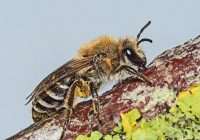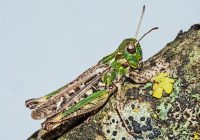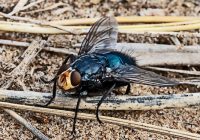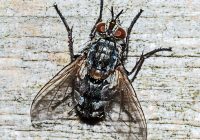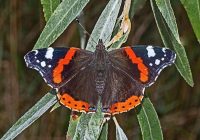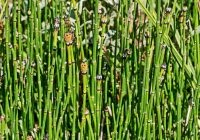Dr Phil Smith’s Wildlife Notes
September 2022
In contrast to earlier months, our rainfall in September was about average, with measureable amounts on 12 days. There were even four properly wet days, something we hadn’t experienced for a long time. Despite this, the sand-dune water-table rose by only 3 cm, probably because the soil was so dry. The Met. Office tells us that the first nine months of 2022 were the warmest since records began in 1884, while it was also the driest year, so far, since 1959. These figures are consistent with a warming trend in Britain, due to climate change that is happening more quickly than predicted.
The summer drought and heat-waves seem to have led to leaf-fall earlier than usual. I noticed that leaves of the Black Poplars along Range Lane, Formby, were already yellow and dropping by 4th September. Being serenaded by the lovely autumn song of the Robin was less unexpected.
During the first week of the month, my emails were dominated by a saga involving the Sea Aster Colletes solitary bee. Firstly, specimens collected at Marshside by Trevor Davenport and me at the end of August were confirmed as Sea Aster Colletes by the national expert, Steven Falk. This was significant because, with the exception of a single individual at North Walney on Morecambe Bay in August 2018, most of the world population was thought to occur on coastal saltmarshes in the south and south-east of England. So what was it doing on the Ribble? Steven asked if we could find some more to be absolutely sure of the ID, so Trevor and I headed to Marshside on 6th and, with permission, walked out to where we found nest-holes in August. Two bees expertly potted by Trevor were also confirmed as Sea Aster Colletes. In the meantime, exciting reports claimed the same bee on the Dee Estuary. I made inquiries, finding that possible Sea Aster Colletes had been seen at Heswall in 2021. More were found this year, identification being confirmed from a few collected specimens. At the same time, there were claims of the same species at Hoylake. My informant said they were present “On every Sea Aster plant on Hoylake beach”, while a possible nest site was located in a nearby garden. I recommended that specimens should be sent to Steven Falk for confirmation but haven’t yet heard the outcome.
The Sea Aster Colletes is very similar in appearance to other related bees, one of these being the Ivy Bee, which has featured in these notes on several occasions since its discovery at Crosby in 2018. Rather than making a sudden jump across country, the Ivy Bee has steadily worked its way north since its first appearance in Dorset in 2001. I had my first for the year on flowering Ivy at Range Lane, Formby on 16th. This insect rarely uses nectar and pollen from another plant but, much to my surprise, a bee on Canadian Goldenrod at Falklands Way, Ainsdale, also turned out to be an Ivy Bee. How much further north does it occur in Sefton? Earlier, I pinpointed a south-facing Ivy patch just off Oxford Road, Southport. Sure enough, on 19th, I found several Ivy bees of both sexes there. A few days later, on my way to Marshside, a diversion led to Hesketh Road, where I spotted another extensive area of flowering Ivy. This also had Ivy Bees, my northernmost so far. Later visits to both patches were graced by three enormous Hornet Plumehorns, the largest of our hoverflies, and two of the rather scarce Pale-knobbed Lucent. Apart from a few Ivy Bees,the Ravenmeols Ivy, which had been so productive in previous years, was less so this month, perhaps mirroring a national decline in many hoverflies due to the spring and summer drought.
Other insect highlights during the month included tiny Slender Groundhoppers at Hightown and Sands Lake, Mottled Grasshopper of the green form at Freshfield Dune Heath, colourful Painted Ladies on Birkdale Green Beach and Hightown shore and a Yellow-faced Blowfly at Hightown dunes. The latter is an impressive insect with a deep turquoise-blue abdomen and pale-yellow face. It is said to have a widespread but scattered distribution, more frequent in the north. I have only seen it on sandy tracks at Hightown. An unexpected sighting on my way back from the Devil’s Hole on 11th was a Hummingbird Hawkmoth zooming about on the old asparagus-field. By the time I got my camera out it had disappeared. I hear there have been several about this summer. One of my favourite butterflies, the Red Admiral, was less frequent than usual but a few were on the Ivy patches and a real beauty posed on a White Willow at Hightown. The same willow produced a completely black Mournful Wasp, whose distribution is mainly southern, while adult and immature Dock Bugs were on nearby vegetation. A large fly on the fence at Wick’s Path, Formby Point, was identified from a photo by expert, Phil Brighton, as Exorista larvarum. Although it’s fairly widespread, there seems to be only one previous Sefton record in 1959 at Ainsdale.
Mentioned in the August notes, my survey of Variegated Horsetail in the sand-dunes was completed during the month. Over the last 20 years, the plant has been recorded at 43 sites; I re-found it at 17, often in reduced quantity, while it had disappeared from 11 localities, due to the growth of tall vegetation and scrub. The remaining 15 sites were too remote for me to access. Another rather esoteric botanical study concerns the hybrid willow Salix x friesiana at the iconic Devil’s Hole blowout, Ravenmeols. This plant is a cross between Creeping Willow and Osier, the parents being quite common, while the hybrid is nationally rare. I have been measuring changes in the number and size of labelled individuals since 2012. This year, they peaked at the extraordinary total of 143 bushes. There are about another dozen places where this hybrid is found in Britain but most of them only have one or two bushes. Hard graft but someone has to do it!

